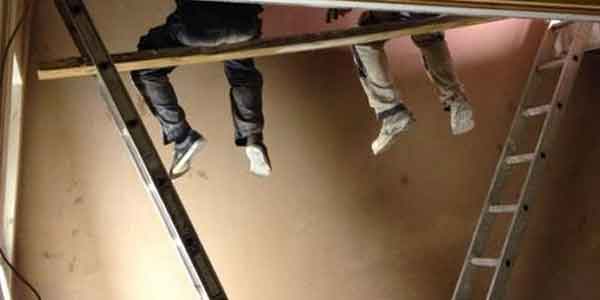Knowing how to plaster well is very important, especially when it comes to creating a smooth and even finish on the walls and ceiling of a room.
If the walls aren’t completely smooth, the final finish once decorated will be poor. Many people assume that plastering is quite an easy job. However, this really isn’t the case at all.
In fact, plastering can be incredibly challenging. It involves a lot of hard work, and it takes its toll on the body, whether you are plastering for a DIY project or are in the trade.

Here, we look at whether plastering is physically demanding and what it involves.
Plastering is a very physically demanding job. Plasterers work on their feet all day and they do a lot of stretching, reaching, and bending. This takes a toll on the body, particularly when working for long periods of time.
Plastering ceilings is especially hard work. It involves a lot of strain on the arm, neck, shoulders, and back muscles. This means you must be quite fit to do plastering.
Do You Have to Be Strong to Be a Plasterer?
Both boarding and skimming plaster are very demanding jobs. Boarding requires you to be quite strong and fit, as you need to be able to lift the weight of the plasterboard’s. You will also need stamina and strength in your arm muscles to skim plaster well.
Applying plaster to the wall isn’t difficult, but getting a smooth topcoat takes time and effort. Your arm, shoulder and hand muscles need to be up to the challenge. It involves a lot of repetitive movements when troweling the plaster. These movements can lead to repetitive strains such as tennis elbow.
How Much Do Plasterboard’s Weigh?
Plasterboard comes in several different sizes. Smaller sizes can weigh as little as 7.5kg. Larger sizes can weigh up to 34kg. Because of this, it can be difficult to handle and fit plasterboard’s, especially on ceilings.
Standard plasterboard’s are usually 2400mm in length by 1200mm wide. This can make them tricky to get into place, especially on your own. It will often involve balancing in awkward positions and in many cases will be a 2-man job.
Lifting long plasterboard’s over your head is difficult too, and you will need to have strong arms and shoulders to lift and keep them in place. If you do find yourself boarding alone, you may opt for a smaller board (1200×900).
Tools To Help Make Plastering Easier
There are lots of tools that can help make plastering easier and relieve the pressure points on your body. Some of these include:
- Power mixer – A power mixer is a powerful machine that helps the plasterer mix plaster quickly and with much less effort.
- Corner trowel – plastering corners is intricate work and difficult. Get it wrong and the whole wall can look terrible. A corner trowel makes it easier to do this job well.
- Stilts – these are useful tools which can save effort and time. They make it easy to plaster difficult to reach areas like ceilings, but they do require balance.
- Drywall screw gun – fitting plasterboard can be difficult ad time consuming. A drywall screw gun makes the job faster and easier.
- Sanders – these are lightweight, flexible tools. They make it fast and easy to sand ceilings and walls. They create a smooth finish with minimal effort.
- Board lift – this tool makes lifting plasterboard easy, without the need to hold them in place. It makes fixing boards to ceilings much simpler and can even make boarding a ceiling a one-man job.
- Mortar stand – this accessory is simple but effective, and it makes plastering a little easier. This small folding table holds the plastering material for easy access. This means less bending is necessary.
- Hawk – hawks are portable surfaces to hold plaster material on the move. A hawk lets you apply plaster with ease on ceilings and walls.
- Long-handled snips – snips are important when plastering, they are used for trimming and cutting beading. Long-handled snips give more leverage. That makes it easier to trim stainless-steel or cold steel beading.
- Skrim taping tools – these automatic tools save lots of time. It means there is no need to apply scrim by hand. They are the fastest way to apply tape to plasterboard.
Does It Take a Long Time to Plaster Walls and Ceilings?
The length of time it takes to plaster walls and ceilings depends on many different factors.
- The bigger the surface that needs plastering, the more physically demanding it is going to be on the plasterer, hence this will take longer.
- Is plaster boarding required or just skimming? If you are only skimming over plasterboard, then the job will obviously be quicker.
- Re-plastering is a completely different issue. This involves re-skimming existing surfaces. However, you will also need to consider any prep work to get the area ready for skimming. This could include bonding, browning, PVA, blue grit, dot and dab. As well as many other potential options.
Due to the variety of different circumstances, it is very difficult to give exact time frames for plastering. As it will vary on a job-to-job basis.
With that said, plastering or re-plastering an average size room, will usually take a decent plasterer between 1 and 2 days.
In Conclusion
Plastering isn’t an easy job, and it can be a lot of hard work. It is demanding on the body, including the legs, arms, shoulders, and hands. It involves a lot of lifting, repetitive movements, standing, stretching, and bending.
The plasterboard’s can be awkward to handle and heavy. It can also take several days to complete a plastering job, so expect a toll on your muscle groups over time. There are some tools available, though, to make plastering walls and ceilings easier. These can reduce the time and effort taken to plaster a room.



